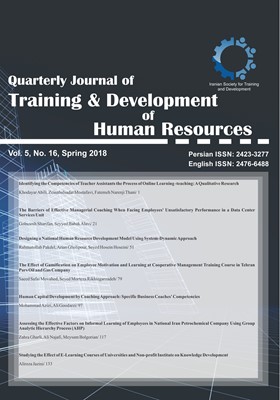شناسایی مدل شکاف عملکرد در سازمان تامین اجتماعی ایران به منظور تغییر رویکرد در آموزشهای مرسوم
الموضوعات :محمد صالحی 1 , شروین مشایخی 2 , ترانه عنایتی 3
1 - دانشگاه آزاد اسلامی
2 - دانشگاه آزاد اسلامی ساری
3 - دانشگاه آزاد اسلامی واحد ساری
الکلمات المفتاحية: عملکرد, شکاف عملکرد, بهسازی عملکرد انسانی, مداخله, آموزش.,
ملخص المقالة :
این پژوهش با هدف شناسایی ابعاد و مؤلفههاي شکاف عملکرد در سازمان تأمین اجتماعی انجام شده و روش اصلی پژوهش حاضر، روش پیمایش بوده است که گردآوری دادهها به کمک پرسشنامه و تحلیل آن به کمک نرمافزار PLS و آمارهای مختلف صورت گرفته است. جامعه آماری پژوهش شامل همه کارکنان سازمان تأمین اجتماعی است که 395 نفر از میان آنان و از روش نمونهگیری تصادفی به عنوان نمونه آماری انتخاب شدند. دادههای گردآوری شده از طریق تحلیل عاملی اکتشافی، عوامل مختلفی تعیین شده و سپس به اتکای تحلیل عاملی تاییدی نهایی شده است؛ و یافتههای پژوهش حاکی از آن است که «شکاف عملکرد» در سه بُعد سبک راهبری، محیط کاری و مدیریت نیروی انسانی قابل توضیح است؛ براساس یافتههای مذکور در بعد اول، مولفههای «رویکرد استراتژیک»، «محیط کار تعاملی و شفاف»، «سبک تفویض اختیار» و «بازخورگیری از ذینفعان»، در بعد دوم، مولفههای «مدیریت عملکرد»، «نظام استخدام و انتصاب»، «کارآمدی ابزارهای انگیزش شغلی»، «آموزش اثربخش»، «نظام جبران خدمت» و «دانش تخصصی» و در نهایت در بعد سوم، مولفههای «انتظام اخلاقی و اطلاعاتی»، «فرهنگ مشارکتی» و «دانشمحوری» تایید شدند. بدین ترتیب ضمن تدوین مدل نهایی شکاف عملکرد در سازمان تامین اجتماعی، درجه تناسب مدل ارائه شده مشخص و برازش آن مدل با مقدار قوی 0.6 مورد تایید قرار گرفت.
1. Talbot C. Theories of performance: Organizational and Service Improvement in the Public Domain. 2010. Oxford: Oxford University Press.
2. Enos D. Performance Improvement: making it happen. 2007. New York: Taylor & Francis Group.
3. Addison R M, Haig C. The Performance Architect’s Essential Guide to the Performance Technology Landscape. 2006. In J. A. Pershing (Ed.). Handbook of human performance technology: principles, practices and potential (3rd ed.). (pp. 35-54). San Francisco, Pfeiffer.
4. Gilmore E R, Pershing J A. Don’t miss! Identify all causes of that performance gap: A review of literature supporting a refinement of Wile’s HPT model. 2001. The annual meeting of the International Society for Performance Improvement, San Francisco.
5. While D. Why Doers Do. Performance and Instruction, 1996; 35 (1): 30-35.
6. Pershing J. Handbook of human performance technology: principles, practices and potential (3rd ed.). 2006. San Francisco: Pfeiffer.
7. Rossett A. Analysis and More. 2006. In J. Pershing (Ed.). Handbook of Human Performance Technology: Principles, Practices and Potential (3rd ed.) (pp. 208-222). San Francisco, Pfeiffer.
8. Khoshmashraban Z. Designing the implementation of a human performance technology (Hpt) model: A study in Sina Bank. Master's Degree, Tehran University, 2013.
9. Ferond C. The origins and evolution of human performance technology. 2006. In J. A. Pershing (Ed.), Handbook of human performance technology: principles, practices and potential (3rd ed.). (pp. 155-187). San Francisco, Pfeiffer.
10. Sabbaghian Z, Akbari S. A Comprehensive Training in Organizations (with Adult Education Approach). 2th ed. 2015. Tehran: Samt Publication.
11. Rothwell, William. Beyond Training and Development: The Groundbreaking Classic on Human Performance Enhancement. 2005. New York: American Management Association.
12. Khorasani A, Vafaeezadeh M. Human Performance Technology: Basics and principles. 2016. Tehran: Ostadan Publication.
13. Picolo J, Machado D, Tontini G, Dockhorn M, Gava S. Using Improvement Gap Analysis for the management of trade-offs of operational strategies. Gest. Prod. 2016; 23(1): 48-59.
14. Fasset . Gap Analysis Report. 2002. Gauteng: Management Consulting Learnership Project.
15. AHRQ. Gap Analysis. Pediatric Toolkit for Using the AHRQ Quality Indicators. 2018. Rockville: Agency for Healthcare Research and Quality
16. Russell-Brown P. Gap Analysis; Final Report. 2016. Kingston: Ministry of Health.
17. Center for Public Health Leadership. Gap Analysis. 2014. Harvard: School of Public Health.
18. UCLA Health. Course Planning Tip Sheet: Gap Analysis. 2016. Los Angeles: UCLA Nursing.
19. WHO. Gap Analysis. Pandemic Influenza Preparedness Framework Partnership Contribution. 2013. Geneva: World Health Organization.
20. Currie, Graham. Gap Analysis of Public Transport Needs: Measuring Spatial Distribution of Public Transport Needs and Identifying Gaps in the Quality of Public Transport Provision. Journal of the Transportation Research Board, 2004. 1895 (1): 137-146.
21. PCG Education. Data Gap Analysis. 2010. Washington: Public Consulting Group.
22. Murray J. The Gap Analysis Process to Improve IT Management. 2000. Florida: CRC Press
23. Mohammadi Sabet M, Fayyazi B, Shah Hoseini M. Designing a model for human performance technology: A study in SAPCO. Iranian journal of management sciences. 2016; 42 (11): 99-124.
24. Rezaee M. Review the gap between the existing and desirable performance of the Balanced Scorecard system: A study in National Iranian Copper Industries Co (nicico). International Conference on Economic Management Accounting and Social science. 2014 May 31. Rasht Iran.
25. Faghihi A, Alizadeh M. Validity in qualitative research. Journal of Organizational Culture Management. 2005; 2 (3): 5-19.


